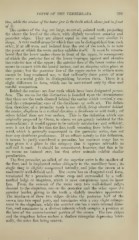Page 389 - My FlipBook
P. 389
TEETH OF THE VERTEBRATA. 399
tion, while the canine of tJie lower jaw is the tooth which closes just in front
The canines of the dog are large, recurved, pointed teeth, projecting
far above the level of tlie others, with slightly trenchant anterior and
posterior edges. They are almost equal in size and very similar in
shape. A very useful means by which they can be distinguished from each
other, if at all worn and isolated from the rest of the teeth, is to note
the point at which the worn surface exhibits itself. It must be remem-
bered that the lower canine closes in front of the upper, in consequence
of which the posterior face of the lower impinges against and abrades
the anterior face of the upper ; the anterior face of the lower canine also
comes in contact with the lateral incisor, and an abrasion takes place at
this point ; but the posterior face of the upper canine is seldom worn
except by long-continued use, so that ordinarily these points of Avear
serve as a useful guide in distinguishing between them. There is a
slight difference in form, which can be ascertained only by close and
careful comparison.
Behind the canines are four teeth which have been designated premo-
lars. The reason for this distinction is founded upon the circumstance
that these are the teeth situated behind the canine wliich vertically suc-
ceed the corresponding ones of the deciduous or milk set. The defini-
tion, therefore, of a premolar tooth is one ichich, being situated behind
the canine, displaces in a vertical direction a deciduous or milk tooth; all
others behind these are true molars. This is the definition which was
originally proposed by Owen, to whom we are greatly indebted for this
nomenclature : it would appear to be entirely satisfactory and sufficient,
Avere it not for the fact that the first tooth counting from before back-
ward, which is generally enumerated in the premolar series, does not
have any deciduous predecessor. If we adhere strictly to this definition,
it cannot be justly considered a premolar, but common usage has so
Icng given it a place in this category that it appears advisable to
still call it such. It should be remembered, however, that this is by
no means an isolated case, but that other animals exhibit similar
peculiarities.
The first premolar, so called, of the superior series is the smallest of
the four, and is implanted rather obliquely in the maxillary bone ; its
single fang is sliglitly compressed laterally, and joins the crown at a
moderately well-defined neck. The crown has an elongated oval form,
terminated by a prominent obtuse cusp and surrounded by a well-
marked ledge or cingulum, which is most conspicuous upon its inner
face. From the summit of the main cusp two well-defined ridges
descend to the cingulum, one on the posterior and the other upon the
anterior border, giving to the tooth a slightly trenchant appearance.
The hindmost of these two ridges divides the posterior half of the
crown into two equal parts, and terminates with a very slight enlarge-
ment in the cingulum, while the anterior one has a more internal direc-
tion, and terminates in a distinct tubercle ^hich occupies a position at
the base of the antero-internal portion of the crown. The two ridges
and the cingulum below enclose a shallow triangular depression inter-
nally, the outer face being convex.


